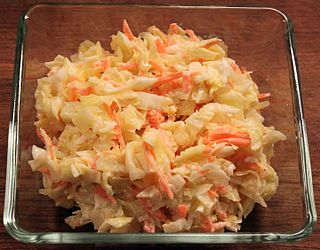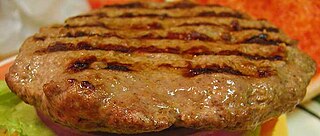Related Research Articles

A beefsteak, often called just steak, is a flat cut of beef with parallel faces, usually cut perpendicular to the muscle fibers. In common restaurant service a single serving has a raw mass ranging from 120 to 600 grams. Beef steaks are usually grilled, pan-fried, or broiled. The more tender cuts from the loin and rib are cooked quickly, using dry heat, and served whole. Less tender cuts from the chuck or round are cooked with moist heat or are mechanically tenderized.

A sausage is a type of meat product usually made from ground meat—often pork, beef, or poultry—along with salt, spices and other flavourings. Other ingredients, such as grains or breadcrumbs may be included as fillers or extenders.

Food drying is a method of food preservation in which food is dried. Drying inhibits the growth of bacteria, yeasts, and mold through the removal of water. Dehydration has been used widely for this purpose since ancient times; the earliest known practice is 12,000 B.C. by inhabitants of the modern Middle East and Asia regions. Water is traditionally removed through evaporation by using methods such as air drying, sun drying, smoking or wind drying, although today electric food dehydrators or freeze-drying can be used to speed the drying process and ensure more consistent results.

Jerky is lean trimmed meat cut into strips and dehydrated to prevent spoilage. Normally, this drying includes the addition of salt to prevent bacteria growth. The word "jerky" derives from the Quechua word ch'arki which means "dried, salted meat".

Pemmican is a mixture of tallow, dried meat, and sometimes dried berries. A calorie-rich food, it can be used as a key component in prepared meals or eaten raw. Historically, it was an important part of indigenous cuisine in certain parts of North America and it is still prepared today. The word comes from the Cree word ᐱᒦᐦᑳᓐ, which is derived from the word ᐱᒥᕀ, "fat, grease". The Lakota word is wasná, originally meaning "grease derived from marrow bones", with the wa- creating a noun, and sná referring to small pieces that adhere to something. It was invented by the Indigenous peoples of North America.

Biltong is a form of dried, cured meat which originated in Southern African countries. Various types of meat are used to produce it, ranging from beef to game meats such as ostrich or kudu. The cut may also vary being either fillets of meat cut into strips following the grain of the muscle, or flat pieces sliced across the grain. It is related to beef jerky; both are spiced, dried meats; however the typical ingredients, taste, and production processes may differ.

Seitan is a food made from gluten, the main protein of wheat. It is also known as miànjīn, fu, milgogi, wheat meat, gluten meat, vital wheat gluten or simply gluten. It is made by washing wheat flour dough with water until most of the starch granules have been removed, leaving behind the sticky, insoluble gluten as an elastic mass, which is then cooked and eaten.

Meatloaf is a dish of ground meat that has been combined with other ingredients and formed into the shape of a loaf, then baked or smoked. The final shape is either hand-formed on a baking tray, or pan-formed by cooking it in a loaf pan. It is usually made with ground beef, although ground lamb, pork, veal, venison, poultry, and seafood are also used, sometimes in combination. Vegetarian adaptations of meatloaf may use imitation meat or pulses.

Carbonara is a pasta dish made with eggs, hard cheese, fatty cured pork, and black pepper. The dish took its modern form and name in the middle of the 20th century.

Moussaka is an eggplant- or potato-based dish, often including ground meat, which is common in the Balkans and the Middle East, with many local and regional variations.

Coleslaw, also known as cole slaw, or simply as slaw, is a side dish consisting primarily of finely shredded raw cabbage with a salad dressing or condiment, commonly either vinaigrette or mayonnaise. This dish originated in the Netherlands in the 18th century. Coleslaw prepared with vinaigrette may benefit from the long lifespan granted by pickling.

Hash browns, also spelled hashed browns and hashbrowns, are a popular American breakfast dish consisting of finely julienned potatoes that have been fried until golden browned. Hash browns are a staple breakfast food at diners in North America, where they are often fried on a large common cooktop or grill.

Dried meat is a feature of many cuisines around the world. Examples include:

Lebanese cuisine is the culinary traditions and practices originating from Lebanon. It includes an abundance of whole grains, fruits, vegetables, fresh fish and seafood. Poultry is eaten more often than red meat, and when red meat is eaten, it is usually lamb and goat meat. Dishes include copious amounts of garlic and olive oil, and dishes are often seasoned with lemon juice. Chickpeas and parsley are also staples of the Lebanese diet.

A patty or burger is a flattened, usually round, serving of ground meat and/or legumes, grains, vegetables, or meat alternatives. Patties are found in multiple cuisines throughout the world.

Chicken and dumplings is a soup that consists of a chicken cooked in water, with the resulting chicken broth being used to cook the dumplings by boiling. A dumpling—in this context—is a biscuit dough, which is a mixture of flour, shortening, and liquid. The dumplings are either rolled out flat, dropped, or formed into a ball.

Chebureki are deep-fried turnovers with a filling of ground or minced meat and onions. They are made with a single round piece of dough folded over the filling in a crescent shape.
References
- ↑ Hurt, Jeanette (6 September 2022). Dehydrating: Simple Techniques and Over 170 Recipes for Creating and Using Dehydrated Foods. Penguin. p. 625. ISBN 978-0-7440-6175-8.
- ↑ Fike, Mark (15 February 2006). "Jerky Made Easy". The Shelton-Mason County Journal. Retrieved 20 December 2023.
- ↑ Fiduccia, Kate (10 July 2018). The Wild Game Cookbook: Simple and Delicious Ways to Prepare Venison, Waterfowl, Fish, Turkey, and Small Game. Simon and Schuster. p. 232. ISBN 978-1-5107-4144-7.
- ↑ Ride, Kevin (3 June 2021). Backcountry Eats: Making Great Dehydrated Meals for Backcountry Adventures. FriesenPress. p. 19. ISBN 978-1-5255-8546-3.